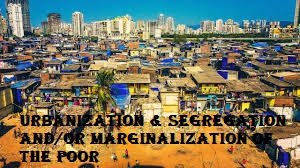Urbanization in Indian metropolises often leads to unequal access to basic services such as water, sanitation, healthcare, and education. The poor, living in marginalized areas of the city, often have limited access to these services, exacerbating their socio-economic marginalization. Here are some key points regarding this issue:
- Housing Segregation: There is a clear division between the rich and poor. Gated communities coexist with extending slums that lack basic amenities. For instance, approximately one-third of Delhi’s residences are part of slums without essential resources.
- Economic Disparities: Inadequate skills lead to poor individuals ending up in informal jobs with no job security or social benefits. They are often seen as a source of cheap labour for affluent residents, perpetuating a cycle of poverty.
- Limited Access to Services: Poor communities face limitations in accessing clean water, healthcare, sanitation, and education.
- Social Exclusion: Discrimination based on factors like caste, religion, and ethnicity further marginalizes the poor. Manual scavenging, a caste-based prohibited practice, still exists in many cities.
- Government Policies: Resource and fund constraints challenge policymakers in providing basic necessities to all urban populations, unintentionally discriminating against the poor. Dharavi, Asia’s largest slum, exemplifies this challenge.
- Gentrification: Wealthier individuals moving into previously low-income neighbourhoods can increase property prices, displacing long-term low-income residents. For instance, the advent of multinational companies in Bengaluru transformed it into the “Silicon Valley of India.”
- Vulnerability to Disasters: Events like the 2023 Delhi floods disproportionately affect low-income groups. Similarly, the COVID-19 pandemic pushed them further into poverty.
Despite these challenges, there are positive aspects for the urban poor:
- Participation in Gig Economy: Flexible work opportunities, such as delivery agents and ride-hailing platforms, provide income for semi-skilled workers.
- Anonymity in Urban Centers: Urban anonymity allows many poor individuals to access opportunities without being defined solely by their caste or other discriminatory identities.
- Government Policy Focus: Recent schemes like AMRUT 2.0, Swachh Bharat Mission-Urban, and PM SVANidhi for street vendors prioritize the urban poor.
To address these issues, comprehensive urban planning, investment in social services, and policies promoting inclusive growth are essential.


